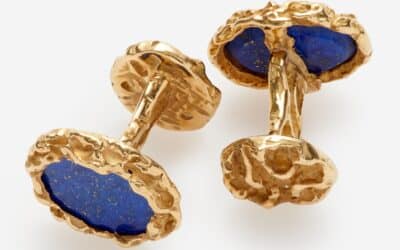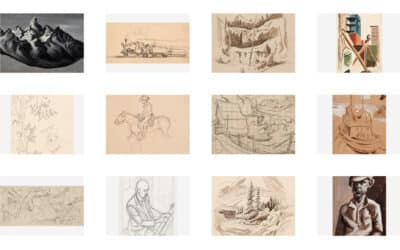
Thomas Hart Benton: Artist of Kansas City
Missouri Roots | Becoming America’s Artist |Kansas City Art Institute | Benton Murals | Home & Studio
By Circle Auction | March 2019
So how did one of the most famous artists of the twentieth century become a permanent figure in Kansas City lore?

Benton’s Missouri Roots:
On April 15, 1889, Thomas Hart Benton was born in Neosho, MO to one of Missouri’s most prominent political families. Young Tom, as he was known to most, loved to draw and constantly sketched scenes from his imagination and his surroundings. His mother supported his artistic aspirations, but his father, a lawyer and four-time U.S. congressman, strongly opposed. “That I should even think of becoming an artist gave him a sense of outrage,” Tom recalled. “It would never do for a Benton to descend so low.”
As a child, Missouri’s rural landscapes and faces became etched in Benton’s mind. When the family relocated to Washington D.C. for his father’s political career, Tom studied the intricate murals in government buildings and imitated the cartoons he saw in the Washington Post. By the time the Bentons returned to Missouri in 1904, Tom’s determination to be an artist had only increased. At the age of 17, he was hired as a cartoonist for the Joplin American, making $14 a week.
Eventually, Benton was allowed to pursue his passion for art, studying at the Art Institute of Chicago before continuing his education at the Académie Julian in Paris. Returning to the states, he taught and painted in New York City and served as a draftsman for the U.S. Navy in WWI. All of these experiences helped young Benton develop a unique style and eye for detail.
Becoming America’s Artist:
In the 1920s, Benton changed his artistic focus. After a trip to Missouri to visit his dying father, he set off on several explorations of the South and Midwest. He spent time walking the countryside, talking with locals, and sketching everything he saw. It was during this period that he deserted modernism and developed his own colorful, stylized realism depicting blue-collar and rural Midwestern life. His work was bold, muscular, and distinctly American.
While quiet and focused in the studio, Benton cultivated a brash, hard-drinking, tough-talking persona for the press, never shying from controversy. His enormous murals, most notably America Today (1930) and The Arts of Life in America (1932) broadened his audience. In 1934, Benton was the first visual artist ever featured on the cover of Time magazine. The accompanying article highlighted his work alongside fellow “earthy midwesterners” Grant Wood and John Steuart Curry. After years of eking out a living, Thomas Hart Benton was now an outstanding artistic success.

THOMAS HART BENTON ON THE COVER OF TIME MAGAZINE
The Artist as Teacher: Thomas Hart Benton at the Kansas City Art Institute:
In 1935, Benton was at the height of his fame. When invited to teach painting at the Kansas City Art Institute, he relocated his young family and moved back toward the source of his artistic inspiration — the American heartland.
Benton’s notoriety was a huge asset to KCAI. Enrollment boomed as students rushed to register for his classes. Some of the artists he influenced during this period include Glenn Gant, Frederic James, Jackson Lee Nesbitt, Roger Medearis, Margot Peet, and Delmer J. Yoakum. Though popular as a teacher, Benton’s penchant for ruffling feathers limited his time at the Art Institute. He refused to give his students grades, contrary to school policy, and he was dismissed in 1941 after publicly accusing several employees of the Nelson-Atkins Museum of being homosexual.
Thomas Hart Benton Murals:
The late 1930s and early 1940s were significant for Benton’s career. He published his autobiography, An Artist in America. He began printing limited edition lithographs. He painted Persephone. And in 1936, he created what he considered to be his best work: a mural inside the state legislature building in Jefferson City.
Longstanding connections with several Missouri politicians helped Benton gain the commission and he engaged some of his KCAI students to assist in the early stages. A Social History of the State of Missouri is a thirteen-panel narrative and contains an impressive 235 individual portraits. These include several of Benton’s family members, well-known figures of Missouri history and legend, and even some infamous faces, such as Boss Tom Pendergast, whose political organization controlled Jackson County politics at the time. With typical boldness, Benton approached Pendergast directly and asked him to model for the mural. Benton considered the Missouri mural to be his best work.

THOMAS HART BENTON PLAYING MUSIC WITH HIS FAMILY IN HIS HOME IN KANSAS CITY.
Thomas Hart Benton Home & Studio:
In 1939, Benton and his wife Rita welcomed their second child and moved to their permanent home at 3616 Belleview, converting the carriage house into an art studio.
Folk music filled their house and inspired many of Benton’s paintings. He picked up the harmonica at age 41 and became so fascinated with it that he invented a new system of harmonica notation. His wife and children were also musical and the family frequently welcomed other artists and musicians into their home. In 1942, Tom and his son, T.P., collaborated with friends to produce a record of folk tunes titled Saturday Night at Tom Benton’s.
After WWII, Abstract Expressionism captured the art world’s imagination and Regionalist artists like Benton fell out of vogue. He never again achieved the lost fame of the 1930s but continued to create masterpieces from his Kansas City studio for the rest of his life. Today, Benton’s significance is unquestionable. He was a master of his craft, uniquely capturing an American era.
At the age of 85, Tom Benton died in his Kansas City studio, just as he was preparing to place his signature on a completed mural for Nashville’s Country Music Hall of Fame. His workspace and house have been preserved as a museum, the Thomas Hart Benton Home and Studio State Historic Site.

MORE ARTICLES
Jewelry
JEWELRY Fine + Designer + Antique Ended May 3rd Shipping Info Circle Auction is excited to present our yearly dedicated Jewelry auction; composed of fine, designer, antique, and Native American jewelry collections from around the Kansas City area. Designer...
Summer Modern + Contemporary
Contemporary + Modern ART & DESIGN | Aug. 9th - 24thREGISTER FOR THE AUCTION Circle Auction is currently assembling our next event focused on modern design and contemporary art, consigned from various collections in Kansas City and around the region.Current design...
Rare Paul Evans Studio Cabinet At Auction
Unveiling a Masterpiece: Rare Paul Evans Studio Cabinet at Auction By Circle Auction | Jan. 2024 A masterpiece of mid-century modern design is headlining Circle Auction's first Modern + Contemporary auction of 2024. A rare sculpted bronze cabinet by the legendary...
Auction Results from Thomas Hart Benton Collection of Original Works
Auction Results from Thomas Hart Benton Collection of Original Works By Circle Auction | Dec. 2023 Campanella Collection of Benton Works Kansas City's Circle Auction concluded the sale of 113 original Thomas Hart Benton works this past December. The...




